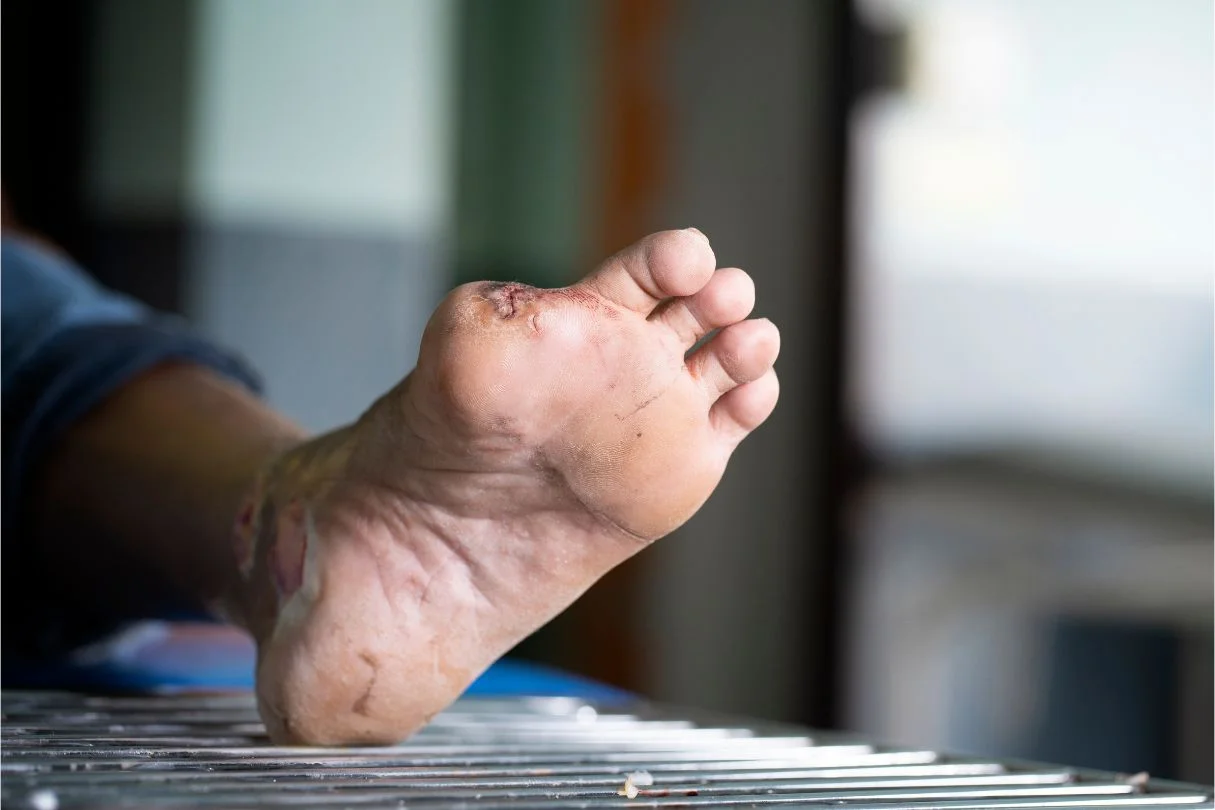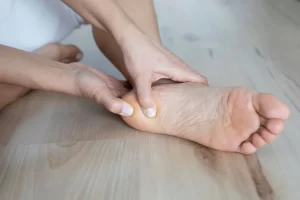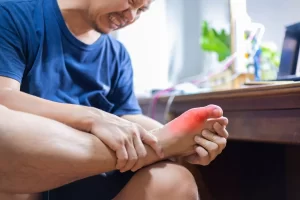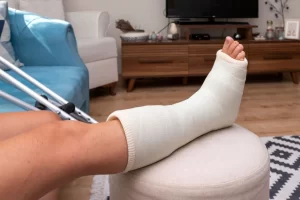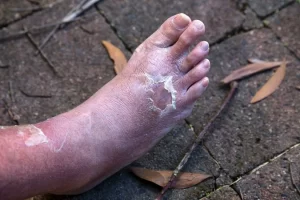Amputations that are caused by diabetes are the ultimate fear for diabetic patients and healthcare professionals. The loss of a limb is a devastating outcome, but it can be preventable with diligent management and proactive care.
In this article, we will provide practical tips and strategies for preventing diabetes-related amputations and reducing your risk of this debilitating outcome.
The risk of diabetes-related amputations
Amputations in diabetic patients most commonly occur in the lower extremities, such as the toes, feet, and legs. Approximately 80% of these amputations are preceded by foot ulcers, which can result from even minor injuries that fail to heal properly due to poor blood circulation and nerve damage.
Here are some key numbers about diabetes-related amputations:
- Around 9 in 10 persons who had a lower limb amputation in Singapore had diabetes. [1]
- Estimated up to 4 diabetes-related amputations are performed every day in Singapore. [2]
- People with diabetes are up to 25 times more likely to undergo an amputation than those without diabetes. [3]
- More than 80% of lower-limb amputations in diabetic patients start with foot ulcers. [4]
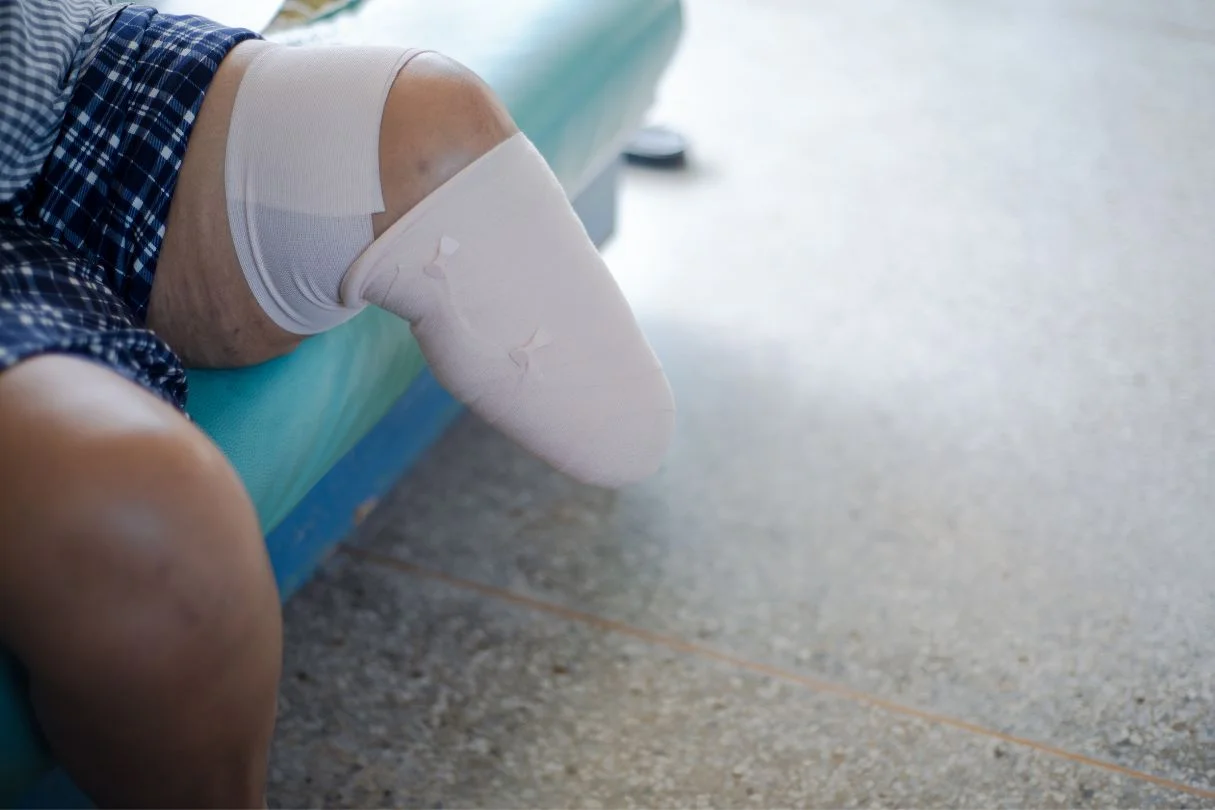
How to prevent diabetes-related amputations?
The prevention of amputations requires a holistic approach that includes managing blood sugar levels, maintaining proper foot care, and seeking immediate medical attention for any foot issues.
Manage blood sugar levels
Make sure to keep your blood sugar levels within the target range to prevent complications that precipitate amputations. Chronically elevated blood sugar levels can damage blood vessels and nerves, reducing sensation and poor circulation in the feet.
Here are some strategies to help you with blood sugar management:
- Eat a balanced diet rich in vegetables, whole grains, and lean proteins. Also, avoid the consumption of excessive sugar and refined carbohydrates.
- Try to become physically active, which is great for blood circulation, weight loss, and blood sugar levels.
- Take your prescribed medications as directed by your healthcare provider compliantly (e.g., insulin, oral hypoglycemics).
- Monitor your blood glucose levels regularly to make sure that they remain within the normal range.
Incorporate foot care into your daily routine
Daily foot care is one of the most effective ways to prevent ulcers and amputations. A simple but consistent routine can identify potential problems before they become severe.
Follow these strategies:
Inspect your feet daily
Check your feet daily for cuts, blisters, redness, and swelling. Use a mirror to view the bottoms of your feet or ask for assistance if needed.
Wash and moisturize
Wash your feet daily with lukewarm water and mild soap. After that, dry them thoroughly, especially between the toes. Apply a moisturizer to keep the skin soft, but avoid applying lotion between the toes to prevent fungal infections.
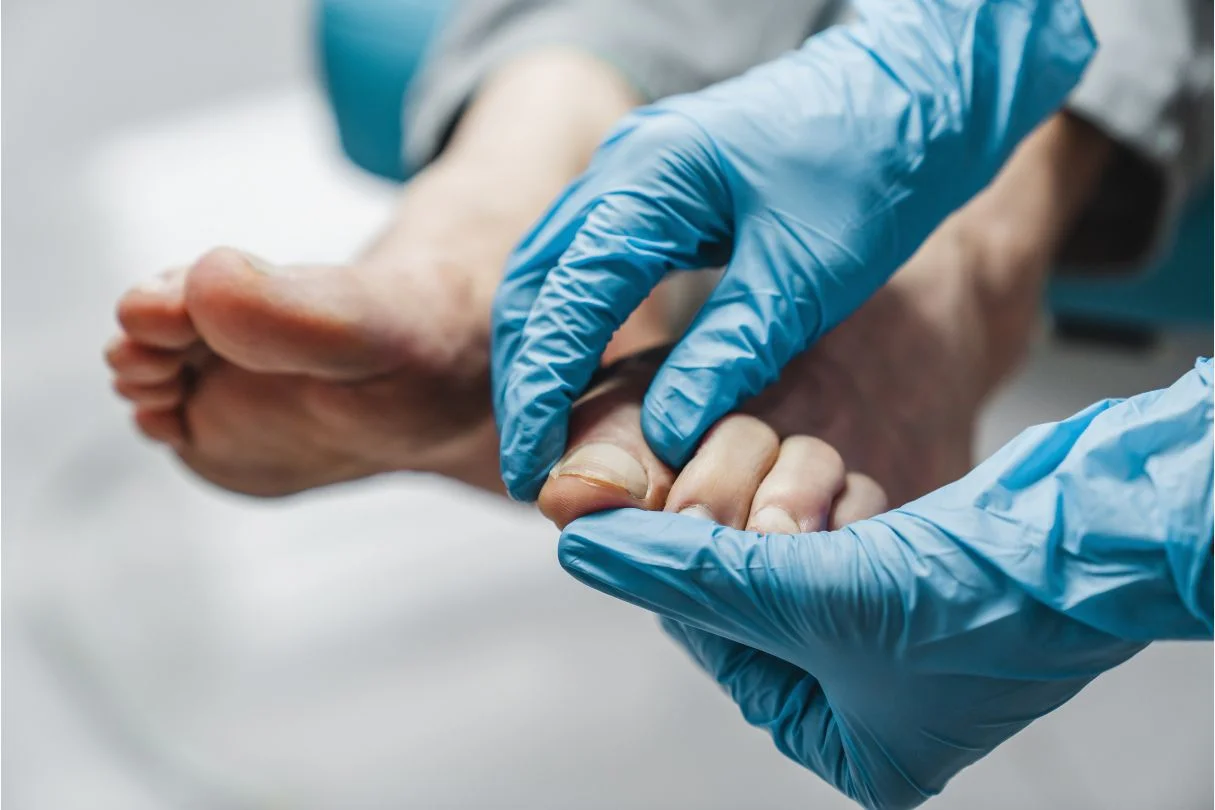
Toenail care
Trim your toenails straight across and file any sharp edges. This prevents ingrown toenails.
Wear proper footwear
Choose shoes that fit well and provide adequate support. Avoid tight shoes and high heels, which cause blisters and sores. Always wear clean, dry socks, and avoid those with tight elastic bands.
Do not do the following!
Certain practices can increase the risk of foot injuries and ulcers, which can ultimately cause amputation.
First of all, do not go barefoot. This seemingly benign practice increases the risk of cuts, scrapes, and injuries that you might not feel due to peripheral neuropathy.
Secondly, avoid home remedies for foot lesions. Do not attempt to remove any corns and calluses, or other foot lesions yourself. Do not apply corn plasters or salicylic acid on any thickened skin areas. Instead, seek professional care from a podiatrist to avoid injury or infection.
Get regular medical checkups
Regular visits to your healthcare provider or podiatrist are essential to monitor your foot and catch any issues early on.
If you have diabetes, you need to have your feet examined by a healthcare professional at least once a year. However, if you have a history of foot ulcers, you need to get examined 2-4 times a year.
Finally, seek medical attention immediately when you notice any signs of diabetic foot infection. These signs may seem benign at first (e.g., redness, warmth, swelling), but they can worsen quickly. Early intervention can save your limb or even your life
Quit smoking
We know you have heard this a thousand times, but that should tell you something. Smoking significantly increases the risk of amputations in people with diabetes, according to a 2017 study. [5]
Chronic smoking impairs blood circulation and triggers low-grade inflammation, which contributes to the development of corns, calluses, and foot ulcers.
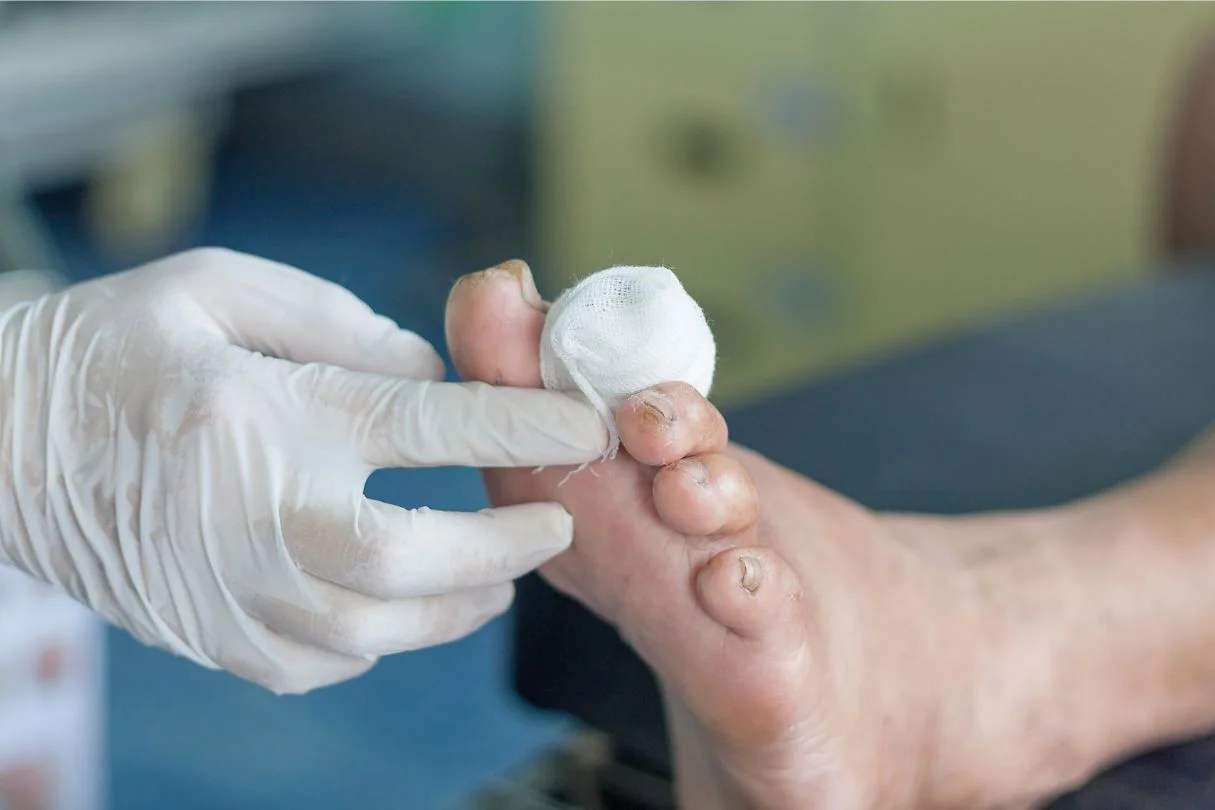
Need Help? See Our Podiatrist Today
Stay on the look for foot ulcers
Diabetic foot ulcers are open sores or wounds that fail to heal properly due to poor blood circulation and nerve damage. They are a significant precursor to amputations, which makes their prevention and early treatment critical.
Signs of foot ulcers are:
- An ulcer that lasts longer than one to two weeks.
- Any ulcer that does not heal or worsen.
- An ulcer larger than 3/4 inch in diameter.
- An ulcer that is deep enough to expose the bone.
If you notice any of these signs, seek medical attention immediately.
Learn how to detect a foot ulcer early in this article.
The table below summarizes some key preventive measures for diabetes-related amputation:
| Preventive measure | Description |
| Blood sugar control | Maintain blood glucose levels within the target range. |
| Daily foot care | Inspect feet daily, wash, moisturize, and wear proper footwear. |
| Regular medical checkups | Annual foot exams and immediate care for any foot issues. |
| Smoking cessation | Quit smoking to improve circulation. |
| Healthy lifestyle | Manage your weight and blood pressure. |
| Diabetic foot team | Procedures to debride foot ulcers, control infection, and restore blood flow for adequate healing. |
How can a diabetic foot team prevent amputation?
One key evidence-based strategy to manage foot ulcers and prevent amputations is having a multidisciplinary care team. A team with various specialists, such as podiatrists, orthopaedic surgeons, and vascular surgeons, can provide well-coordinated holistic care.
For example, an individual with a severely infected diabetic foot ulcer may require an orthopaedic surgeon to remove dead infected tissues surgically. For individuals with severe PAD or diabetic foot ulcers, vascular surgery may be necessary to improve blood flow and prevent amputation. A podiatrist can then manage the wound through regular debridement and offloading to ensure the wound heals completely and prevents recurrence.
You can learn more about the benefits of multidisciplinary management of diabetic foot ulcers in this article.
Multidisciplinary Diabetic Foot Team
At Straits Podiatry, we have a dedicated diabetic foot care team that works closely with orthopaedic surgeons and other specialists to provide holistic management of any diabetic foot complications. Our goal is to ensure that you are seen quickly and have a tailored and coordinated management plan, so that we can minimise the risk of amputations.
If you suspect that you may have a diabetic foot ulcer or a non-healing wound, contact us or schedule an appointment today.
Takeaway message
Diabetes-related amputation is a life-altering complication that can be prevented when proper measures are put in place. Remember, vigilance and a commitment to foot care are key to prevention. Regular checkups, a healthy lifestyle, and smoking cessation are all critical components of an effective prevention strategy.
References
- https://www.niddk.nih.gov/health-information/professionals/diabetes-discoveries-practice/reducing-disparities-in-diabetic-amputations
- https://corp.nhg.com.sg/Media%20Releases/LEA%20Singapore_FINAL_edited.pdf
- https://www.ncbi.nlm.nih.gov/pmc/articles/PMC10543925/
- https://www.ncbi.nlm.nih.gov/pmc/articles/PMC8316286/
- https://www.ncbi.nlm.nih.gov/pmc/articles/PMC5774386/
Podiatrist experienced in diabetic foot management and amputation prevention.
Jackie Tey
Chief Podiatrist, B.Pod(Hons). Your foot and lower limb specialist passionate about raising awareness for foot and lower limb health.

